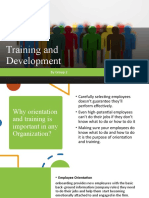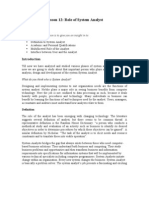Unpacking Kirkpatrick: Data-Driven Decision Making in L&D
Unpacking Kirkpatrick: Data-Driven Decision Making in L&D
Uploaded by
Olena YakovenkoCopyright:
Available Formats
Unpacking Kirkpatrick: Data-Driven Decision Making in L&D
Unpacking Kirkpatrick: Data-Driven Decision Making in L&D
Uploaded by
Olena YakovenkoOriginal Title
Copyright
Available Formats
Share this document
Did you find this document useful?
Is this content inappropriate?
Copyright:
Available Formats
Unpacking Kirkpatrick: Data-Driven Decision Making in L&D
Unpacking Kirkpatrick: Data-Driven Decision Making in L&D
Uploaded by
Olena YakovenkoCopyright:
Available Formats
Unpacking Kirkpatrick
DATA-DRIVEN DECISION MAKING IN L&D
CONTENTS
Unpacking Kirkpatrick: Data-Driven Decision Making in L&D.....................1
The Kirkpatrick Model......................................................................................3
Working Backwards.........................................................................................4
When to Use Kirkpatrick..................................................................................5
Level 1: Reaction..............................................................................................6
Level 2: Measuring Learning...........................................................................9
Level 3: Behavior Change..............................................................................11
Level 4: Measuring the Results.....................................................................13
Putting Kirkpatrick to Practice.......................................................................15
Calculating ROI................................................................................................16
Outcome Flowchart........................................................................................18
Recommended Resources.............................................................................19
Unpacking Kirkpatrick: Data-Driven Decision Making in L&D
When it comes to building an employee development plan, a lot of time and attention goes into the prep work:
program managers identify skill gaps, develop a training strategy, deliver training, reinforce training, and then the
cycle starts again.
Inevitably, someone in a leadership position will ask to see how the investment into employee development is
paying off, and unless you’ve taken an intentional approach to measuring the outcomes of your training efforts,
you’ll struggle to paint an accurate portrait of the impact your program has on your organization!
If your organization is acquired or merges with another company, you will absolutely need real statistics that prove
the value of your program. Some stats, like training usage, indicate strong program health, but that doesn’t mean
those statistics are evidence of meaningful business impact.
When you can demonstrate to leadership that your training efforts have reduced turnover by 13%, and saved the
company $40,000 in recruiting costs, your training program is in a strong position to position itself as contributing
to true business results.
Unpacking Kirkpatrick: Data-Driven Decision Making in L&D 1
Getting to those specific numbers can be challenging, and training is sort of nebulous, which means that
rarely are hard numbers easily calculated.
Fortunately, a guy named Donald Kirkpatrick came around and modeled a solution to this dilemma, a training
measurement solution called the Kirkpatrick Model.
This model contains four levels: reaction, learning, behavior, and results.
We’re going to go into each of those levels more in depth, but at a high level, the model essentially asks you to
measure how the learners reacted to their training, how their attitude or skills trained, whether that change
was long-term, and whether that change led to a desired outcome.
Unpacking Kirkpatrick: Data-Driven Decision Making in L&D 2
The Kirkpatrick Model
Measure your participants’ initial reaction to gain an understanding
REACTION of the training program and valuable insights into material quality,
educator, and more.
Measure how much information was effectively absorbed during the
LEARNING training and map it to the program or individual learning objectives.
Measure how much your training has influenced the behavior of the
BEHAVIOR participants and evaluate how they apply this information on the job.
RESULTS
Measure and analyze the impact your training has had at the business
level, and be sure to tie it to the individual program.
Keeping statistics that prove the value of your training program should become a part of your training process and following the Kirkpatrick Model makes
that possible!
Unpacking Kirkpatrick: Data-Driven Decision Making in L&D 3
Working Backwards
Training should never be done for the sake of training; rather training should always be tied to a
business goal. For this reason, when it comes to the Kirkpatrick Model, it’s recommended to start at the
end.
Level 4 asks trainers to measure and analyze the impact that your training has on your business’ desired
outcomes. Defining those desired outcomes must be step one before you assign any training.
We’ll use a sales rep as an example. Many people in this position spend hours-on-end dialing phone
numbers, talking to prospects, and qualifying them.
A few of sales reps are struggling to meet their goals, and leadership recognizes that your training
program and great content can develop their skills and help them meet quotas.
Unfortunately, a one-size-fits-all approach will rarely work here. Ask questions and identify why they’re
underperforming. If you’re not entirely sure what the necessary skills are, work with their managers to
identify skill gaps.
Find out if they need help finding motivation to make more calls, or if they struggle to gain a prospect’s
attention in a quick and timely manner. Whatever they need, identify a specific set of skills that will lead
to a desired business outcome.
Unpacking Kirkpatrick: Data-Driven Decision Making in L&D 4
If you identify that your rep is struggling specifically with making enough dials a day, find out what is
hindering them. Maybe they struggle ending conversations that aren’t leading to productivity. Perhaps
they struggle entering information into your customer tracking software and need training on that
specific software.
If you train for those skills and see that they are now able to make more calls per day, and that has
improved your revenue growth, then you’ve succeeded! In the same vein, if there’s a discrepancy
between the actual result and your desired outcome, the Kirkpatrick Model can help you understand
why!
When to Use Kirkpatrick
This ebook is not a workbook. If you’re reading this in hopes that it will help you evaluate your last training
event, this book will probably not help unless you’ve already done steps 1-3.
Kirkpatrick should become a part of your training process. As you identify training needs and form a plan
to fill those needs, each step should become a part of your process.
For instance, level 1 calls for program managers to measure a learner’s reaction. As you decide training
delivery, you should also decide how you’ll measure reaction.
Kirkpatrick is part of building a learning strategy, so it requires pre-planning. Before you create your next
training event, read through levels 1-4, and you'll be in a strong position to record meaningful statistics for
your program!
Unpacking Kirkpatrick: Data-Driven Decision Making in L&D 5
Level 1: Reaction
The Kirkpatrick Evaluation Model first step should be planned before you deliver training, but first takes effect the moment training has been delivered. It’s
important to catch the reaction of your learner(s), and that’s where level 1 begins.
Recent research from Training Industry outlines a few facts that training program managers need to keep in mind as they deliver training:
• Different employees require different types of training
• The training topic affects what modality employees prefer
• Using multiple modalities (blended learning) makes you more likely to meet learner preferences
• Training delivered through a preferred modality is more effective
Understanding how learners want to learn will make your training efforts significantly more effective, because training is far more effective when it’s
delivered according to a learner’s preference.
Furthermore, knowing that training topics affect what modality the employees prefer means that seeking feedback is always necessary, even if you believe
you understand a learner’s preference.
What that means is that when you are training your customer support team on phone skills, they may prefer online learning, but that doesn’t mean they’ll
still prefer online learning when it becomes time to take training about a new product launch.
When you do inevitably fail to reach a desired outcome, returning to level 1 and evaluating whether training was well received will almost always illuminate
why there was a breakdown.
We know that the way we deliver training, or the modality, matters, and that makes it important to measure. The question now is “how?”
Unpacking Kirkpatrick: Data-Driven Decision Making in L&D 6
Here is where we begin data collection, starting with the oldest trick in the data-lover’s book: the survey.
Make sure that questions you ask will help you determine whether training was in-tune with your learners’ preferences.
Some questions that we recommend discovering answers to are:
• Was the training engaging?
• Did the training teach you something new?
• Did you like the style of this training?
• How would you change this training for future learners?
• Did you like the method of this training?
• Are there any resources that you think would help reinforce this training?
When it comes to surveys, the more specific feedback you get, the better. And make sure it’s written down!
Unpacking Kirkpatrick: Data-Driven Decision Making in L&D 7
Here are some examples of feedback, from bad, to better, to best:
BAD
Learners seemed to enjoy today’s training. Most feedback was positive.
BETTER
Learners seemed to enjoy online learning more than the classroom training we conducted as a follow up. One learner
said “I liked having the video option because I can go back and watch as many times as I need.”
BEST
Today’s classroom training on emotional intelligence was a follow-up to our week-long video training process. We asked
employees whether they thought that our blended approach was an improvement on our typical process, and 82% (41/50)
said that it was. We had a bit of negative feedback, many agreed that they didn’t like starting on a Thursday, because the
weekend interrupted the learning process. Starting on a Monday and ending on a Thursday may be a better approach in the
future. All the surveys said that learners did appreciate the shorter content spread over many days. We attribute the
preparation and engaging short-form content to a very engaging classroom session, where discussion flowed very naturally
and lots of questions were asked.
In other words, the more specific you are, the better positioned you are to identify why
training was successful or unsuccessful.
Level 1 is important because the most effective training needs to be delivered the right way, and when your training is unsuccessful, the
feedback you receive on level 1 of the Kirkpatrick Model will help you understand why.
Unpacking Kirkpatrick: Data-Driven Decision Making in L&D 8
Level 2: Measuring Learning
Learners need to be taught according to their learning preferences, but training needs to be
effective for ROI to exist.
If you showed your learners Disney’s The Lion King, they may tell you they enjoyed their time.
But if your goal is to increase productivity on a factory line, the Disney classic will prove useless
to achieving results. Measuring learning follows immediately after the event, and level 2 will help
you evaluate how learners perceive your training.
If you’re investing time into creating your own training, or money into third-party content, it’s
vital to the success of your program that what you offer your learners actually works.
We’re left with a question: how do we measure the effectiveness of training?
Unpacking Kirkpatrick: Data-Driven Decision Making in L&D 9
Fortunately, there are plenty of tools available to measure the effectiveness of your training. The simplest and most common is to offer a quiz or test
following your training.
Testing not only measures how effective training is, it also reinforces training, because learners are asked to recall what they’ve learned. Research shows
that testing after a training event leads to higher retention over time, so test early and test often!
Testing also provides usable data about the effectiveness of your program. Asking ten-to-twenty questions that measure a learner’s recall gives you an
easy-to-calculate percentage of how much information your learners are retaining.
At BizLibrary, our videos come with quizzes that require 80% accuracy to complete. That’s a great benchmark to look for in your training. If your learners can
average 80% or better on tests, it’s great evidence that your training program is doing a good job of teaching your learners.
Poor performance may be disappointing, but it’s constructive feedback indicating your training needs improvement. If you believe this is the case, be sure
to view our free ebook “Off-the-Shelf Content: Your Secret to Optimizing Employee Training.”
Testing isn’t the only way to measure the effectiveness of training. Some
professionals advocate hands-on assignments, and that’s a great way to
evaluate how a learner might perform following a training event.
Regardless of how you measure the effectiveness of a given training event, make sure your data
is reliable and recorded somewhere.
Unpacking Kirkpatrick: Data-Driven Decision Making in L&D 10
Level 3: Behavior Change
We mentioned in the introduction that training should be tied to a business goal. In this phase, we measure behavior changes,
and in the next phase, we determine whether that behavior change led to the business outcome that we hoped it would.
Measuring behavior change requires you to track behaviors and collect data before training, then compare after.
Let’s use the example of a sales team. Leadership wants to see your company’s revenue grow, and after talking to sales reps and
sales managers, you and the managers believe that the the biggest obstacle to your sales growth is that sales reps aren’t asking
for the sale.
You develop and execute a strategy, and learners both respond positively and test well.
At this point, you can identify whether a behavior change has occurred. If you can see that sales reps are actively asking for the
sale, you’ve created meaningful behavior change.
Just because your behavior change is what you set out to accomplish doesn’t mean that your training led to your desired
business outcome.
If you’re closing more deals, but revenue growth isn’t occurring, it may indicate that you misidentified the cause of your
stagnant revenue. Perhaps low client retention is the cause of your slowed revenue growth, and closing more deals hasn’t
closed the gap.
With data, it’s easy to be misled, or to focus on the wrong data set, so consider several attributions when analyzing data. If you
haven’t scrutinized your final data, someone else will, and you will be blindsided.
Unpacking Kirkpatrick: Data-Driven Decision Making in L&D 11
Attributing Your Data Sets
If your company installs pools for customers, and you begin your training program in March and
train through June, you’re almost guaranteed to see a sales increase following your training; but that
doesn’t mean your training led to that sales increase. It’s harder to sell a pool in the fall than it is in the
summer, so timing must be a part of your attribution. If you sell a product that has a “busy season,”
consider comparing your data year over year rather than month over month.
You know your company best,
so keep in mind several factors when you conduct level 3 evaluation.
At this point, you may be noticing that even before we calculate the final-outcome statistics behind
training, following the Kirkpatrick Model will almost instantly improve the way you deliver training.
By breaking the process into stages, you get a clear picture of which stages are working and which stages
need improvement in the process.
Unpacking Kirkpatrick: Data-Driven Decision Making in L&D 12
Level 4: Measuring the Results
It’s at this stage that you’ll finally discover measurable numbers that your training results have had on your
company’s business outcomes.
You started by identifying this outcome, so it shouldn’t be difficult
for you todetermine what outcome you’re actually measuring.
Let’s use employee turnover as an example. After talking to leadership, management, and employees, and after
analyzing exit interviews, you believe that your high turnover can be attributed to struggling middle
management.
Specifically, data that you’ve analyzed lead you to believe that your managers don’t always provide meaningful
feedback, and sometimes fail to delegate effectively, creating stress during projects.
Unpacking Kirkpatrick: Data-Driven Decision Making in L&D 13
In response, you create a management bootcamp where all managers take courses and are given 1-on-1 attention to improve
their feedback and project management with an emphasis on delegation. Tests indicate that your training is effective, and
after a few months, employee feedback has transformed.
Employees respond that their managers provide meaningful feedback, and project management is a much better experience
for all employees.
This may seem like enough data to report back to leadership, but leaders don’t care if managers are providing meaningful
feedback unless that meaningful feedback leads to a decrease in turnover, which is what we set out to reduce in the first
place.
Telling your leaders that turnover was costing your organization $80,000 every quarter, and you were able to cut that cost
down by $25,000 each quarter through training is convincing, meaningful, and measurable with The Kirkpatrick Model!
Unpacking Kirkpatrick: Data-Driven Decision Making in L&D 14
Putting Kirkpatrick to Practice
Now that you have a clear understanding of the four levels of training evaluation, it’s a good time to put your
new knowledge into practice. The great thing about Kirkpatrick is that it’s easy to understand and proven to
work. Here are some things to keep in mind that will improve the reliability, accuracy, and ease of your
statistical calculations:
Important Things to Keep in Mind
There may be multiple attributions that factor into an outcome.
Behavior change is not the same thing as a desired outcome.
Use data to make decisions. This is most easily completed by conducting surveys, and interviewing employees
and managers to identify training needs.
Before designing how you will improve an outcome, find a baseline for what that outcome currently is actually
happeing. This will help you know whether or not your efforts led to an improvement.
Testing is an important part of learning evaluation.
When there is a discrepancy between your desired outcomes and your achieved outcomes, work backwards to discover what that might mean.
Unpacking Kirkpatrick: Data-Driven Decision Making in L&D 15
Calculating ROI
If your training is tied to a business challenge, there should be a number involved at some
point. If your goal is to increase productivity at a factory, you will have a benchmark KPI to
compare against.
Ultimately, the best stat to produce to leadership is ROI. We know you know what it is, but
just so we’re all on the same page, we’ll write it as a formula here...
RETURN
ROI
(BENEFIT)
INVESTMENT
(COST)
Unpacking Kirkpatrick: Data-Driven Decision Making in L&D 16
Examples of Calculating an ROI
In this example, you work in a water bottle factory and your employees produce 500 water bottles every hour. If after 10 hours in
training on lean manufacturing, your employees are able to increase productivity by 10%, and you now make 550 water bottles every
hour, you have a return.
Let’s first calculate return.
In this scenario, 50 more water bottles every hour increases hourly profits in your factory by $8.00 /hour. If you work 8 hour days, your
factory now generates an extra $64/day. Standardized to a year comprised of 52 five-day, weeks, your company has experienced a
return of $16,640.
There was a cost to training, which is primarily found in the cost of training plus the cost of the time.
Let’s say you spent $2,000 in time and resources building training, and over ten hours, you lost 5,000 water bottles.
If each water bottle represents $0.16 in profit, the ten hours costed your factory about $8,000.
The investment in training costed your company a total of $10,000.
Now we have both return - $16,640 – and investment, $10,000. We can now plug those numbers into an ROI equation!
In this scenario, you’ve created a 66.40% return! You can now confidently claim that after training, your factory’s profitability increased
by 66.4% that year.
Unpacking Kirkpatrick: Data-Driven Decision Making in L&D 17
Here is an easy flow chart to help you evaluate failure in your evaluation!
START
Did you achieve your desired outcome?
YES NO
Great work! Time to calculate your ROI. Did your employees behavior change?
NO YES
Did effectiveness measurements like testing If behavior changed but desired
indicate that training was effective. outcome did not, your
hypothesis was failed! That’s
okay, make a new one!
YES NO
Was the content you trained on Re-evaluate your training, find
relevant to the behavior change NO out what worked and what didn’t
you want to see? and try again!
YES
Was the feedback you gathered positive or
mostly positive?
YES NO
Make sure that your training is reinforced Work to seek feedback and determine learner preferences, and build a plan
through boosts, testing, and repetition. around finding training that works for your workforce!
Unpacking Kirkpatrick: Data-Driven Decision Making in L&D 18
Through accurate data collection, evaluation, and objective analysis, you can prove the value of your training program, earn new champions to help fight for
training in your organization, and provide a meaningful and statistically provable difference in your organization!
The Kirkpatrick Model is easy to use, provides clear and reliable results, and can transform the conversation around your training program!
Recommended Resources
Using data to transform your program isn’t easy, and a lot of legwork needs to be done before your program can mature to this stage.
If you’re not quite there, but excited to get there, check out these resources to help you accelerate the growth of your training program!
VIEW EBOOK VIEW WEBINAR VIEW INFOGRAPHIC VIEW INFOGRAPHIC
BizLibrary is a leading provider of online learning for growing organizations. Our award-winning microlearning video library engages employees of all levels,
and our learning technology platform is a progressive catalyst for achievement. Partnered with our expert Client Success and Technical Support teams,
clients are empowered to solve business challenges and impact change within their organizations. To learn more, visit www.bizlibrary.com.
Unpacking Kirkpatrick: Data-Driven Decision Making in L&D 19
You might also like
- CIPD L&D Annual Survey Report 2015Document45 pagesCIPD L&D Annual Survey Report 2015angelfire23phNo ratings yet
- ATD Trainers Guide Delivering Exceptional Learning ExperiencesDocument18 pagesATD Trainers Guide Delivering Exceptional Learning ExperiencesJStoneNo ratings yet
- Instructional Module Training PlanDocument5 pagesInstructional Module Training Planapi-246767803100% (1)
- Human Resources Training and DevelopmentDocument42 pagesHuman Resources Training and DevelopmentAhmad Izzat HamzahNo ratings yet
- Lead With Emotional IntelligenceDocument15 pagesLead With Emotional IntelligenceElay CalinaoNo ratings yet
- Leadership Training PDFDocument30 pagesLeadership Training PDFpatientsafetyNo ratings yet
- 70-20-10 Learning Model PDFDocument5 pages70-20-10 Learning Model PDFJuan BendeckNo ratings yet
- 07 Facilitation Skill LevelsDocument1 page07 Facilitation Skill LevelsleksanathsingaporeNo ratings yet
- Training and Development Initiatives in Different OrganizationsDocument17 pagesTraining and Development Initiatives in Different OrganizationsSusmita Sahu (Hunny)No ratings yet
- PDF Micro Learning Grov o 2015Document19 pagesPDF Micro Learning Grov o 2015sbasultov100% (1)
- Facilitator GuideDocument103 pagesFacilitator GuideElizJayNo ratings yet
- (Diann Wilson, Ellen M. Smilanich) The Other Blend (BookFi) PDFDocument306 pages(Diann Wilson, Ellen M. Smilanich) The Other Blend (BookFi) PDFSugi Sugandi100% (1)
- Employee Development and Talent ManagementDocument12 pagesEmployee Development and Talent ManagementAnkita Dey GroverNo ratings yet
- A PRACTICAL Guide To Training and DevelopmentDocument25 pagesA PRACTICAL Guide To Training and DevelopmentERMIYAS TARIKU100% (1)
- L D Pioneers Reports EMEADocument33 pagesL D Pioneers Reports EMEAStefania LeonteNo ratings yet
- 17 Management Development CipdDocument7 pages17 Management Development CipdMuhammad Osama100% (1)
- Training and DevelopmentDocument6 pagesTraining and DevelopmentMARC URRUTIA MIRÓNo ratings yet
- Facilitation SkillsDocument8 pagesFacilitation SkillsHolden Kirby M Valdez100% (1)
- Presentation On MeetingsDocument29 pagesPresentation On Meetingsnidhi agrawalNo ratings yet
- Banff Centre Competency Matrix ModelDocument3 pagesBanff Centre Competency Matrix Modellloyd814No ratings yet
- Common Coaching ScenariosDocument2 pagesCommon Coaching ScenariosAariv Gabriel100% (1)
- Leadership Competencies MJanttiDocument30 pagesLeadership Competencies MJanttiSabu VincentNo ratings yet
- Clinical Leadership Training Facilitators Guide FINALDocument48 pagesClinical Leadership Training Facilitators Guide FINALrevathidadam555550% (1)
- Leadership Development - Past, Present and FutureDocument9 pagesLeadership Development - Past, Present and FutureAmeer AbbasNo ratings yet
- Leadership Training SeminarDocument11 pagesLeadership Training SeminarIshaq Bin Sadiq0% (1)
- Assigning Leadership Tasks Unit 5Document66 pagesAssigning Leadership Tasks Unit 5Zendy LanzagaritaNo ratings yet
- L&D in 2020Document2 pagesL&D in 2020D Factor100% (1)
- L5 Associate Diploma in Organisational Learning DevDocument77 pagesL5 Associate Diploma in Organisational Learning DevkaranNo ratings yet
- Coaching & Mentoring ResearchDocument8 pagesCoaching & Mentoring ResearchLucas PadrãoNo ratings yet
- CIPD Level 5 Intermediate Diploma in Human Resource ManagementDocument4 pagesCIPD Level 5 Intermediate Diploma in Human Resource ManagementMbaStudent56No ratings yet
- Difficult Conversations WorksheetDocument4 pagesDifficult Conversations Worksheetraj bizNo ratings yet
- Capgemini T D ProjectDocument24 pagesCapgemini T D Projectashok_abclNo ratings yet
- HR Competency Model AssessmentDocument6 pagesHR Competency Model Assessmentlepsa_shakya100% (1)
- Handbook On Instructional Design-V2Document38 pagesHandbook On Instructional Design-V2ukalNo ratings yet
- Training and Development by Group2 - ManishDocument37 pagesTraining and Development by Group2 - ManishUtkarsh Pandey100% (1)
- Return On Investment: in TrainingDocument31 pagesReturn On Investment: in TrainingManisha Bhatnagar100% (1)
- Building A High-Performance CultureDocument61 pagesBuilding A High-Performance CultureMadiNo ratings yet
- BHMT CC Development-PlanningDocument34 pagesBHMT CC Development-PlanningAndra MihalcioiuNo ratings yet
- Measuring ROI in Learning & Development: Case Studies from Global OrganizationsFrom EverandMeasuring ROI in Learning & Development: Case Studies from Global OrganizationsNo ratings yet
- Workplace LearningDocument3 pagesWorkplace Learningperera.randikaNo ratings yet
- 70 20 10 Into ActionDocument11 pages70 20 10 Into ActionCorporate L&D100% (1)
- Preparing and Defending Your Training BudgetDocument24 pagesPreparing and Defending Your Training BudgetMuhammad KadryNo ratings yet
- Leadership Capabilities Framework Project 050519Document6 pagesLeadership Capabilities Framework Project 050519Fajri FebrianNo ratings yet
- Collaborative LeadershipDocument18 pagesCollaborative LeadershipEfren Baruela JrNo ratings yet
- Updated ICF Core Competencies English Brand UpdatedDocument7 pagesUpdated ICF Core Competencies English Brand UpdatedSubham KumarNo ratings yet
- CIPD Foundation Certificate in People Practice: LevelDocument9 pagesCIPD Foundation Certificate in People Practice: Levelviviana 01No ratings yet
- McClelland and Occupational CompetencyDocument6 pagesMcClelland and Occupational CompetencypsychometrikNo ratings yet
- 5e's Instructional DesignDocument4 pages5e's Instructional DesignGerick Dave Monencillo VenderNo ratings yet
- 2019 CPLP Certification Handbook Final PDFDocument50 pages2019 CPLP Certification Handbook Final PDFnupur rastogiNo ratings yet
- Executive Coaching Case StudyDocument5 pagesExecutive Coaching Case Studymatthewivan0% (1)
- OTHM Level 7 Diploma Human Resource Management Spec2Document4 pagesOTHM Level 7 Diploma Human Resource Management Spec2mNo ratings yet
- 3.1 Facilitator Skills GuideDocument143 pages3.1 Facilitator Skills GuideJessa Joy Alano LopezNo ratings yet
- Hersey-Blanchard Situational Leadership TheoryDocument17 pagesHersey-Blanchard Situational Leadership TheoryDahrshini MuraleeNo ratings yet
- Integrating Leadership Development and Succession Planning Best PracticesDocument25 pagesIntegrating Leadership Development and Succession Planning Best PracticestalalarayaratamaraNo ratings yet
- Setting Goals and Objectives TrainingDocument26 pagesSetting Goals and Objectives TrainingOlena YakovenkoNo ratings yet
- Best Practices in Preparing Your Workforce For Success: Training and DevelopmentDocument32 pagesBest Practices in Preparing Your Workforce For Success: Training and DevelopmentOlena YakovenkoNo ratings yet
- Employee: Top 5 Predictors ofDocument21 pagesEmployee: Top 5 Predictors ofOlena YakovenkoNo ratings yet
- Management Fundamentals: Delegation: Learning and DevelopmentDocument24 pagesManagement Fundamentals: Delegation: Learning and DevelopmentOlena YakovenkoNo ratings yet
- EdWel PMP Exam Preparation Course Ebook ExcerptDocument11 pagesEdWel PMP Exam Preparation Course Ebook ExcerptSPNo ratings yet
- PL-PBI-HSE 001 Project HSE PlanDocument22 pagesPL-PBI-HSE 001 Project HSE PlanTadaya KasaharaNo ratings yet
- Final Draft Terms of Reference NewDocument14 pagesFinal Draft Terms of Reference NewIES-GATEWizNo ratings yet
- 0 - 91181 - 16may2016132513 - Demoliton Work PlanDocument29 pages0 - 91181 - 16may2016132513 - Demoliton Work PlanLytzkie George Palada100% (2)
- PM3.5 Planning BudgetingDocument6 pagesPM3.5 Planning BudgetingLegend AnbuNo ratings yet
- Chapter 12 - Project Management 1 (The Business Case)Document24 pagesChapter 12 - Project Management 1 (The Business Case)DeanJulienneNo ratings yet
- Project ManagementDocument7 pagesProject ManagementRameez BhaijeeNo ratings yet
- Tor PMCDocument27 pagesTor PMCAbhishek NaithaniNo ratings yet
- Planner Resume SampleDocument10 pagesPlanner Resume Samplerv nidinNo ratings yet
- Sed Application System Redmine Setting in Project ManagementDocument5 pagesSed Application System Redmine Setting in Project ManagementYanchi1993No ratings yet
- Construction ManagementDocument21 pagesConstruction ManagementTadesse MegersaNo ratings yet
- Module 1 Course 3Document13 pagesModule 1 Course 3Nishim AbdullaNo ratings yet
- Career Objective:: Post Qualification ExperienceDocument10 pagesCareer Objective:: Post Qualification ExperienceDeepanshi NandiNo ratings yet
- John H. Smith: IT Project ManagerDocument2 pagesJohn H. Smith: IT Project ManagerHarsha KashyapNo ratings yet
- Construction Project Manager Cover LetterDocument5 pagesConstruction Project Manager Cover Letterwyukqzfmd100% (1)
- Role of SAnalystDocument11 pagesRole of SAnalystPallavi GuptaNo ratings yet
- Risk Management Term Paper TopicsDocument8 pagesRisk Management Term Paper Topicsafmzswxbbbbitf100% (1)
- Designer - A Service ProviderDocument16 pagesDesigner - A Service ProviderDipti ShuklaNo ratings yet
- JNTUA MCA V Semester R17 SyllabusDocument24 pagesJNTUA MCA V Semester R17 SyllabusVärshû DâŕlînğNo ratings yet
- Earned Value ManagementDocument17 pagesEarned Value ManagementRobMNo ratings yet
- Title Building Dr. Sunil Kulkarni'sDocument3 pagesTitle Building Dr. Sunil Kulkarni'sSanjay BalaramNo ratings yet
- Soft Eng AnswerkeyDocument4 pagesSoft Eng AnswerkeyJoseph EscovidalNo ratings yet
- Clearly Articulated Request For Information (RFI) And/or Request ForDocument9 pagesClearly Articulated Request For Information (RFI) And/or Request ForTimiNo ratings yet
- A Briefly Introduction To Test-Driven DevelopmentDocument3 pagesA Briefly Introduction To Test-Driven DevelopmentJason Cárcamo C.No ratings yet
- PMP-Basics You Need To Know: By: Pradeep Patel PMPDocument14 pagesPMP-Basics You Need To Know: By: Pradeep Patel PMPUmmer BavaNo ratings yet
- YDocument68 pagesYAmit SharmaNo ratings yet
- CQM Brochure - MeritphaseDocument19 pagesCQM Brochure - MeritphaseEr Moosa Mohammed100% (1)
- JP - ISL 30R - Agile Delivery LeadDocument4 pagesJP - ISL 30R - Agile Delivery LeadZubeen ShahNo ratings yet
- Internship ReportDocument29 pagesInternship ReportsigidadannavarNo ratings yet
- Lecture 1 - Chapter 1 - Introduction To Project MGTDocument33 pagesLecture 1 - Chapter 1 - Introduction To Project MGTzenebe sisayNo ratings yet





























































































